RogueRose
International Hazard
    
Posts: 1585
Registered: 16-6-2014
Member Is Offline
|
|
Purifying FeSO4 (Ferrous Sulfate) solution, filtering & removing acid & crystalizing
I've found that FeSO4 is the most difficult of sulfates to filter, remove acid and crystalize of all the sulfates I've tried. I'm always afraid that I
have Fe2(SO4)3 contamination or something I do is going to make it turn into the iron (III) sulfate.
A little over a year ago I had some beautiful light green FeSO4 crystals but they eventually turned mustard brown color and just looked HORRIBLE!! I
decided to try a few things to see what had happened to them so I took 3 samples and place them in HCl (31.45%), DH2O and H2SO4 31%
First two pics are HCL, H2O and 31% H2SO4 respectively from left to right
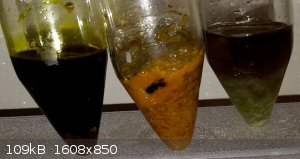 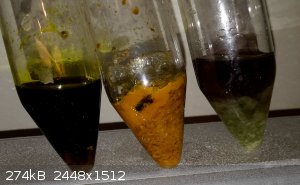
This is a closer look at the DH2O and H2SO4. There are really nice crystals forming in the H2SO4 while the DH2O looks like rust.
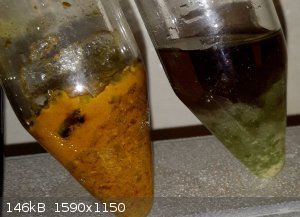
I had about 1L of crystals that had oxidised and seeing how the above resulted in nice crystals with the 31% H2SO4, I added about 25% H2SO4 to the
bottle, allowed to mix and it turned to a grey color with some odd yellow flakes and occasional green crystal remaining. I heated to boiling while
stirring, then decanted liquid and filtered. The liquid was a dark dark green at this point. I took the filtrate and vacuum distilled removing about
250ml of water and was left with what is below which was coating the sides of the boiling bottle.
It is a fairly thick paste with a little green liquid on top (fairly viscous - so probably H2SO4 of higher concentration). I took some of the liquid
and placed it in a vial with some water to see what color solution it would make and that is what is in the final picture.
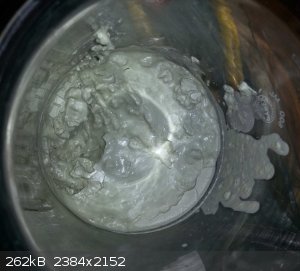 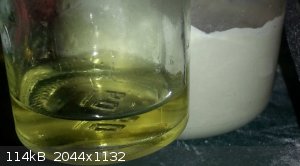
What I don't know is how to get any remaining acid out of the part I boiled down. there is a lot more for me to boil down which has less acid, but I
want to remove as much as possible.
Also, I have a vial I tried to upload pics of but my phone is being a dick. after about 3 months of having 31% H2SO4 and about (12ml) and about 1.5ml
of 35% H2O2 and 5 pieces of nails, I have what looks like a clear solution with a large amount of white precipitate (with a few black specks on the
bottom, which I believe are coagulated carbon molecules..?) I'll upload pics ASAP when both my phone and tablet start working again (have no idea
how both stopped transferring files at the same time....)
|
|
|
Mabus
Wiki Master
  
Posts: 238
Registered: 3-11-2013
Member Is Offline
Mood: Energetic
|
|
I was able to recrystallize a small amount of FeSO4 a few months ago, and got some nice small greenish crystals, after a few attempts. What I noticed
is that if you heat the solution until boiling, the solution will darken in color, similar to that from your photos, but when I only heated the
solution to about 60-70 C, I got good looking crystals, with little oxidation. Haven't tried on larger scale, it's a pretty frustrating salt to
recrystallize properly.
|
|
|
DraconicAcid
International Hazard
    
Posts: 4278
Registered: 1-2-2013
Location: The tiniest college campus ever....
Member Is Offline
Mood: Semi-victorious.
|
|
I think that if you want to purify it by crystallization, it's easier to add ammonium sulphate and crystallize it as Mohr's salt.
Please remember: "Filtrate" is not a verb.
Write up your lab reports the way your instructor wants them, not the way your ex-instructor wants them.
|
|
|
RogueRose
International Hazard
    
Posts: 1585
Registered: 16-6-2014
Member Is Offline
|
|
Voth sugestions make sense. I watched a video about adding ammonium sulphate and it is supposed to make a very stable compound that isn't
hygroscopic, has a VERY long shelf life etc and can be substituted for FeSO4 in many applications supposedly.
Whay I've found is that when I had greed & brown oxidation originally, I added a little acid (about 25ml of 30% and another 15ml of 90% H2SO4 and
then about 100ml of water). Everything inside turned white-ish grey and looked like dried or crushed bone.
In the pictures of the vials, IDK of you can see the images of the nice green crystals in the vial where I added H2SO4, but they turned out really
nice, cubic like, with some kind of yellow flakes on the bottom. This took about 3-4 months for it to get this way and was a cloudy green/brown/black
mess when I added the 30% H2SO4 originally and there was a lot of yellow flakes in the solution, which seemed to settle to the bottom now. I wanted
to copy this result and then filter everything and then purify the filtered solution.
I do think the temp has something to do with color. I'll have to take some pics of the transitions because there were points when I thought I had
LOTS of Fe2(SO4)3 in the solution because it was so brown or white when originally adding the water. but as time went by it all turned to a semi-dark
green, not the light green of the crystals, but darker. I'll post pics later as I'm working on it now.
I can say that ferrous or iron sulfate is MUCH more difficult to work with than is copper sulfate!
|
|
|
Fantasma4500
International Hazard
    
Posts: 1677
Registered: 12-12-2012
Location: Dysrope (aka europe)
Member Is Offline
Mood: dangerously practical
|
|
for making iron salts you wanna work on a larger scale than test tube scale or use pedantic measures ensuring oxygen doesnt get to it, i would suggest
adding butane as its heavy and relatively inert
my memory of iron sulfate is that it has poor solubility in sulfuric acid solution, so instead of trying to neutralize the solution as you would
usually do and boil it down (keeping sulfuric acids boiling point in mind, and decomposition products) simply make a concentrated solution and keep
H2SO4 concentration strong, approx 70% H2SO4 is where it starts to fume, you would wanna let the solution cool down very slowly to form as big
crystals as possible supposing youre after pure iron sulfate, you could maybe approach iron sulfate through iron hydroxide if you have some fancy
filtration device laying around, method would be to simply add sulfuric acid to the hydroxide, keeping hydroxide in excess and then filtering it
another interesting method is adding excess steel wool to a solution of copper sulfate, if you were to use larger pieces of steel and maybe adding
some butane keeping a saturated solution of copper sulfate at 20*C - copper sulfate being 32g/100mL@20*C while iron sulfate being 28.8g/100mL@20*C you
would likely be able to very slowly form iron sulfate crystals, likely as clear as glass
|
|
|